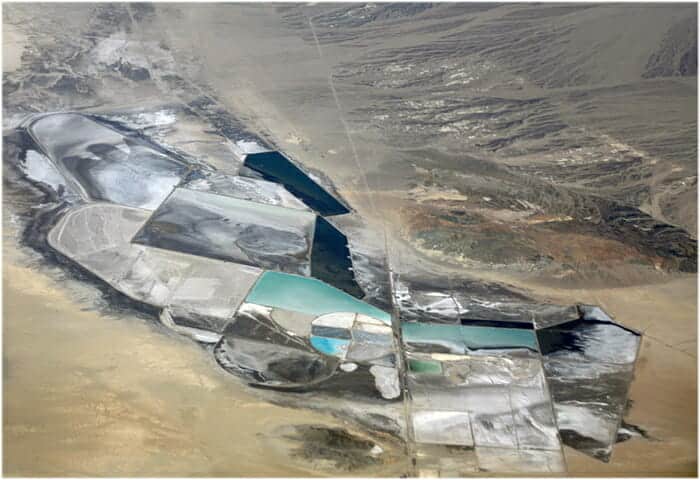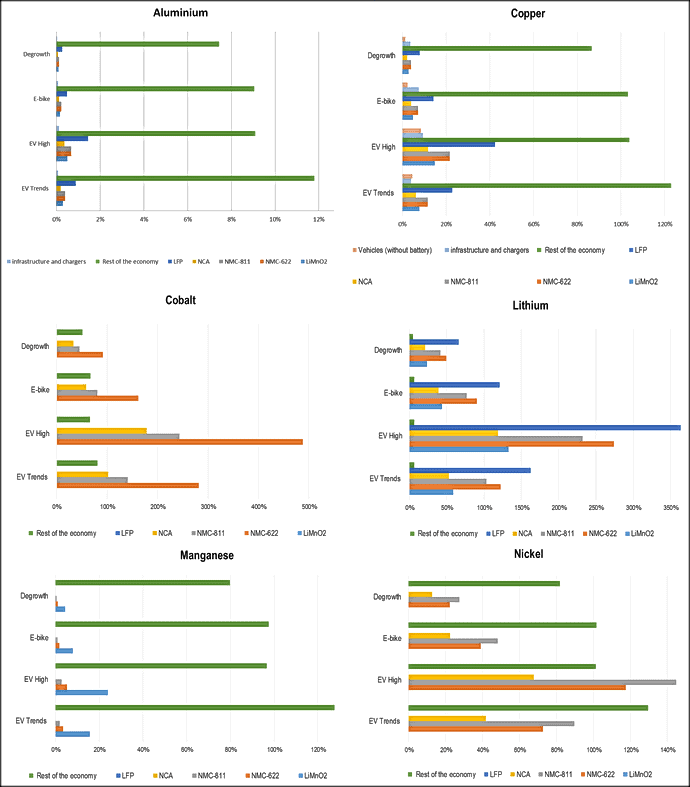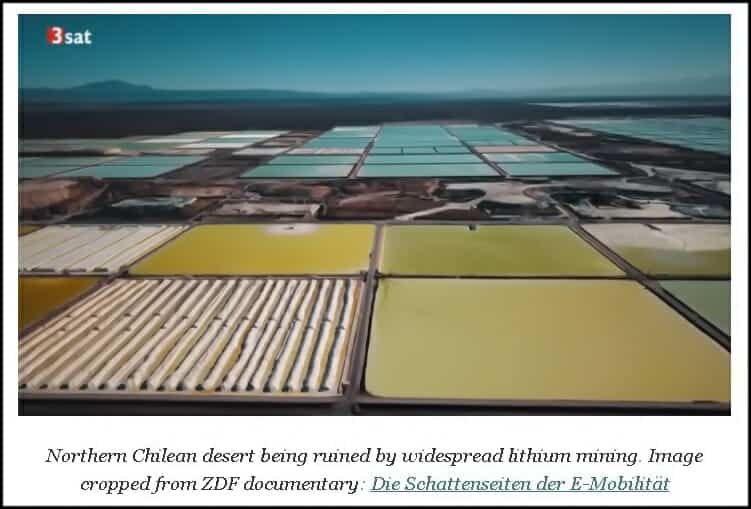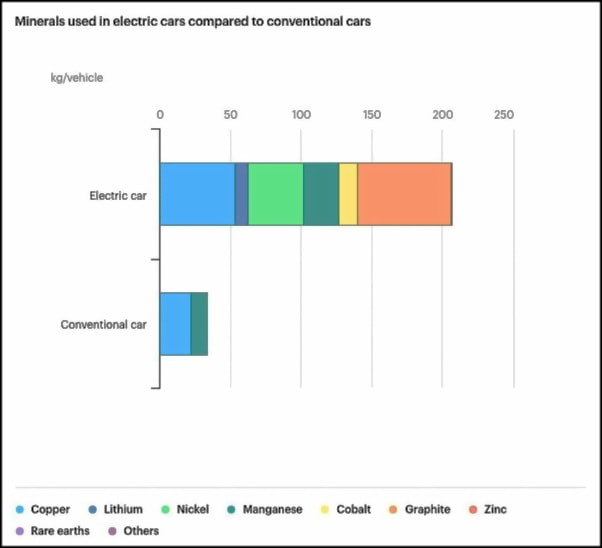Siddharth Kara is an author and expert on modern-day slavery, human trafficking, and child labor. Look for his new book, “Cobalt Red: How the Blood of the Congo Powers Our Lives,” on January 31, 2023
I updated my “EV Car Batteries“ section of my post with this.
BATTERIES
In an excellent post linking to a German documentary (30-minutes) and study showing the devastation to Chili of lithium mining, we find the following:
German ZDF public television recently broadcast a report showing how electric cars are a far cry from being what they are all cracked up to be by green activists.
The report titled: “Batteries in twilight – The dark side of e-mobility” [now not available] shows how the mining of raw materials needed for producing the massive automobile batteries is highly destructive to the environment. For example, two thirds of the cobalt currently comes from the Congo, where the mining rights have been acquired by China. Other materials needed include manganese, lithium and graphite.
Every electric car battery needs about 20 – 30 kg of lithium.
The mining of the raw materials often takes place in third world countries where workers are forced to work under horrendous conditions and no regard is given to protecting the environment. When it comes to “going green”, it seems everything flies out the window….
- The production of lithium through evaporation ponds uses a lot of water – around 21 million litres per day. Approximately 2.2 million litres of water is needed to produce one ton of lithium. (EURO NEWS)
AGAIN… here is a Facebook post of the same thing regarding Lithium Fields:
This is a Lithium leach field.
This is what your Electric Car batteries are made of.
It is so neuro-toxic that a bird landing on this stuff dies in minutes.
Take a guess what it does to your nervous system?
Pat yourself on the back for saving the environment.
Chile, 2nd largest lithium producer, is having water-scarcity problems as this technology takes so much water to produce battery-grade lithium. 2000 tons: 1 ton.
And the current version of the “inflation reduction act” wants 100% of EV battery components produced in the US.
Lead, nickel, lithium, cadmium, alkaline, mercury and nickel metal hydride.
Batteries are a collection of things that are extremely deadly.
Alternative fuels/energy is a DIRTY BUSINESS… but the left who live in the seclusion of the New York Times and MSNBC would never know this. I can show a graph showing skyrocketing carbon emissions worldwide for the past decade and that the temperature has dropped during this time by a small amount, and it is like showing them instructions to build an IKEA bookcase with instructions written in Gaelic! 
What about the impact and supply of the materials needed to produce batteries? TreeHugger has a good post that mentions some of these environmental pitfalls. These issues involve many devices we use daily (cell phones, lap-top computers, rechargeable batteries, etc.), but add to this burden a mandated or subsidized car industry:
…lithium batteries take a tremendous amount of copper and aluminum to work properly. These metals are needed for the production of the anode & the cathode, cables and battery management systems. Copper and aluminum have to be mined, processes and manufacturing which takes lots of energy, chemicals and water which add to their environmental burden.
[….]
First of all, this study emphasizes that there would be less Lithium available than previously estimated for the global electric car market. It also states the fact that some of the largest concentrations of Lithium in the world are found in some of the most beautiful and ecologically fragile places, such as The Salar de Uyuni in Bolivia. The authors note:
“It would be irresponsible to despoil these regions for a material which can only ever be produced in sufficient quantities to serve a niche market of luxury vehicles for the top end of the market. We live in an age of Environmental Responsibility where the folly of the last two hundred years of despoilment of the Earth’s resources are clear to see. We cannot have “Green Cars” that have been produced at the expense of some of the world’s last unspoiled and irreplaceable wilderness. We have a responsibility to rectify our errors and not fall into the same traps as in the past.”
[….]
The report estimates that there would be less Lithium available than previously estimated for the global electric car market, as demand is rising for competing markets, such as cellular telephones and other electronic devices. At the same time, due to a great concentration of Lithium found in Chile, Bolivia and Argentina (70% of the world’s deposits), the United States and other developed countries needing the material will be subject to geopolitical forces similar to those they have already encountered from the member countries of OPEC…
Click HERE to go to larger file (use mouse wheel to zoom in)

In an excellent article we see the projected demands on other metals involved in the battery and transit goals:
….Regarding the demand for the different minerals, in the case of aluminum, according to our results, the demand for minerals from the rest of the economy would stand out, with the requirement for batteries having little influence. Copper would have a high demand from the rest of the economy, but it would also have a significant demand from vehicles, infrastructure and batteries. Cobalt would be in high demand because of the manufacture of batteries with the exception of the LFP battery that does not have this mineral, in the case of its demand from the rest of the economy it can be stated that it would be important but less influential than the demand for batteries. Lithium would have very high requirements from all the batteries and with a reduced demand from the rest of the economy. Manganese would have an important but contained demand coming from LMO and NMC batteries, since the requirements for this mineral would stand out in the rest of the economy. Finally, nickel would have a high demand from NMC and NCA batteries, but its main demand would come from the rest of the economy.
The batteries that would require the least materials are the NCA and LFP batteries. The NMC battery has been surpassed in performance and mineral usage by the NCA. The LiMnO2 battery has a very poor performance, so it has been doomed to disuse in electric vehicles. In addition, the LFP battery, the only one that does not use critical materials in the cathode (other than lithium), also has poor performance, requiring very large batteries (in size and weight) to match the capacity and power of batteries using cobalt.
Charging infrastructure, rail and copper used in electrified vehicles could add up to more than 17% of the copper reserve requirement in the most unfavourable scenario (high EV) and 7% in the most favourable (degrowth), so these are elements that must be taken into account…..
(GEEDS)
Half of all Cobalt made goes into electric cars.
Are Electric Vehicles really clean? | They run on dirty energy and blood of children as young as 6. | Electric cars drive human rights abuse and child labour. | China is one of the villains in this story. | Are electric carmakers equally guilty too? | Palki Sharma Upadhyay tells you.
TO MAKE MATTERS WORSE….
…. lithium is also not the only battery ingredient with a dark side. Perhaps the darkest of all is cobalt, which is commonly used, alongside lithium, in the batteries of many electric vehicles.
More than half of the world’s cobalt is mined in the Democratic Republic of the Congo (DRC). According to a 2016 Amnesty International Report, 20% of the cobalt exported from the DRC comes from artisanal mines, in which miners use either their hands or very basic tools to dig out rocks from tunnels deep underground, often for as little as $2 a day.
Worse still, UNICEF estimates 40,000 of the workers in these mines are children under the age of 18, with some as young as 7 years old. Cobalt mining also comes with serious health risks. Chronic exposure to dust containing cobalt can cause the potentially fatal lung disease “hard metal lung disease.” Many fatal accidents have also been caused by mines not being constructed or managed safely.
Clearly then, in the face of such widespread environmental damage and human rights abuses, the ethics of electric vehicles is far more complicated than the expensive car adverts and glowing newspaper headlines would have us believe…..
(VARSITY)


